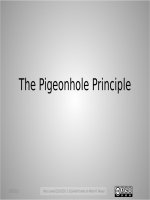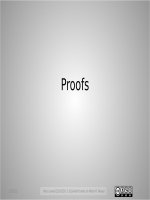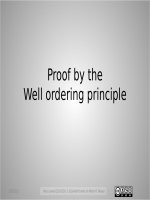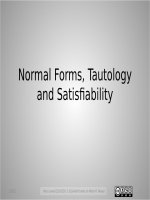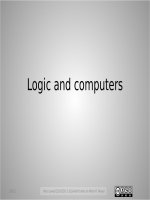Discrrete mathematics for computer science basic probability
Bạn đang xem bản rút gọn của tài liệu. Xem và tải ngay bản đầy đủ của tài liệu tại đây (1.57 MB, 13 trang )
Basic Probability:
Outcomes and Events
4/6/12
1
Counting in Probability
What is the probability of getting
exactly two jacks
in a poker hand?
lec 13W.2
lec 13W.2
Counting in Probability
Outcomes:
Event:
Pr{2 Jacks} ::=
5-card hands
hands w/2Jacks
Ê4ˆ˜Ê52- 4ˆ˜
Á
˜˜Á
˜˜
Á
Á
Á
Á
˜
˜
Á
Ë2 ¯Á
Ë 3 ˜˜¯
≈ 0.04
Ê52ˆ˜
Á
˜˜
Á
Á
Á
Ë 5 ˜˜¯
lec 13W.3
Probability: Basic Ideas
•
A set of basic experimental
•
A subset of outcomes is an
•
outcomes
aka the Sample Space
event
The probability of an event (v. 1.0):
# outcomes in event
Pr{event }::=
total # outcomes
lec 13W.4
Basics of the 2-Jacks problem
•
•
•
An outcome is a poker hand
The sample space is the set of all poker hands
We are assuming that all hands are equally likely (no stacked
deck, no cheating dealer)
•
4/6/12
The event of interest is the set of poker hands with two jacks
5
Flipping 10 coins
& getting exactly 5 heads
•
•
•
•
•
10
Outcomes := {H,T}
Event := {x1…x10: each xi is H or T and exactly 5 are H}
10
|Outcomes| = 2
= 1024
|Event| =
10
5 = 252
Pr(exactly 5 heads) = |Event|/|Outcomes|, which is a little less
than one-fourth.
4/6/12
6
Assumptions!
1.
2.
3.
Fair coin: H and T equally likely
No flip affects any other
So all 1024 sequences of flips are equally likely
In practice human beings don’t believe 2, and can be skeptical
about 1
TTTTTTTTTx: What will x be?
4/6/12
7
Independent Events
•
•
Events A and B are independent iff Pr(A∩B) = Pr(A) ∙ Pr(B).
•
•
•
•
Then |A|=512, |B|=512, Pr(A)=.5, Pr(B)=.5
4/6/12
For example, let
– A = third flip is H = {H,T}2H{H,T}7
– B = fourth flip is T = {H,T}3T{H,T}6
A∩B = {H,T}2HT{H,T}6, |A∩B| = 256
Pr(A∩B) = 256/1024 = .25 = Pr(A) ∙ Pr(B)
So A and B are independent events
8
Non-Independent Events
•
•
•
•
•
•
•
•
4/6/12
Consider sequences of 4 flips
A = at least 1 H
B = at least one run of 3 T
Pr(A) = 15/16 since all but one sequence of 4 flips includes an H
Pr(B) = 3/16 since B = {TTTT, HTTT, TTTH}
A∩B = {HTTT, TTTH}
So Pr(A∩B) = 2/16 ≠ Pr(A) ∙ Pr(B) = 45/256
0.1875 ≠ 0.17578125
9
Some Basic Probability Facts
•
0 ≤ Pr(A) ≤ 1 for any event A
•
•
•
•
•
Pr(∅) = 0.
4/6/12
– Since 0 ≤ |A|/|S| ≤ 1 whenever A⊆S.
Pr(S) = 1 if S is the sample space.
Pr(A∪B) = Pr(A)+Pr(B) if A∩B = ∅.
Pr(A) = Pr(S-A) = 1-Pr(A)
P(A∪B)
_ = P(A)+P(B)-P(A∩B) for any events A, B
(Inclusion/Exclusion principle).
10
Calculating Probabilities
•
Which is more likely when you draw a card from a deck?
•
The sample space is the same in either case, the 52 cards. So we
can just compare the numerators
4/6/12
– A: that you will draw a card that is either a red card or a face card
– B: that you will draw a card that is neither a face card nor a club?
11
Calculating Probabilities
•
•
•
•
A: a red card or a face card
B: not a face card and not a club
= S – (face or club cards)
|A| = |red|+|face|-|red face| = 26+12-6=32
|B| = |S|-|face or club|
= |S|-|face|-|club|+|face club|
•
4/6/12
= 52-12-13+3 = 30
So more likely to draw a red or face card
12
Finis
4/6/12
13
